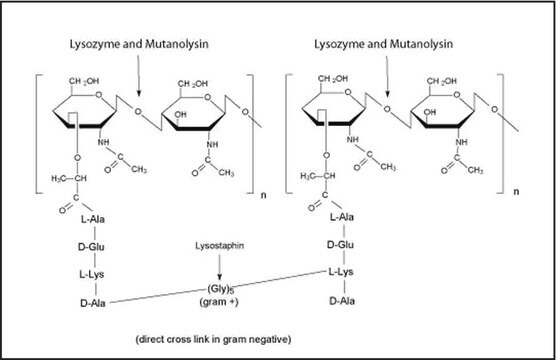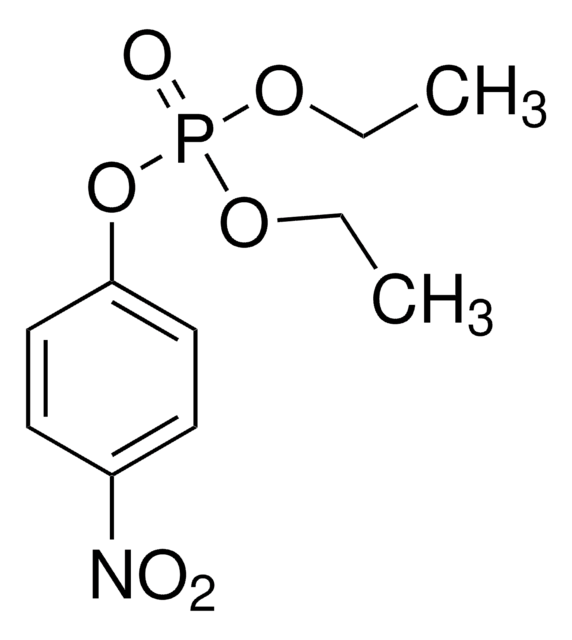14202
Diisopropyl-fluorophosphatase
≥30 U/mg
Autenticatiper visualizzare i prezzi riservati alla tua organizzazione & contrattuali
About This Item
Prodotti consigliati
Origine biologica
fermentation/recombinant
Livello qualitativo
Forma fisica
lyophilized solid
Attività specifica
≥30 U/mg
Temperatura di conservazione
−20°C
Confezionamento
Bottomless glass bottle. Contents are inside inserted fused cone.
Definizione di unità
One unit corresponds to the amount of enzyme which hydrolyzes 1 μmol diisopropyl fluorophosphate per minute at pH 8.1 and 22 °C
Avvertenze
Danger
Indicazioni di pericolo
Consigli di prudenza
Classi di pericolo
Resp. Sens. 1
Codice della classe di stoccaggio
11 - Combustible Solids
Classe di pericolosità dell'acqua (WGK)
WGK 1
Punto d’infiammabilità (°F)
Not applicable
Punto d’infiammabilità (°C)
Not applicable
Dispositivi di protezione individuale
Eyeshields, Gloves, type N95 (US)
Certificati d'analisi (COA)
Cerca il Certificati d'analisi (COA) digitando il numero di lotto/batch corrispondente. I numeri di lotto o di batch sono stampati sull'etichetta dei prodotti dopo la parola ‘Lotto’ o ‘Batch’.
Possiedi già questo prodotto?
I documenti relativi ai prodotti acquistati recentemente sono disponibili nell’Archivio dei documenti.
Marc-Michael Blum et al.
Chemico-biological interactions, 187(1-3), 373-379 (2010-03-09)
The calcium-dependent phosphotriesterase diisopropyl fluorophosphatase (DFPase) from the squid Loligo vulgaris efficiently hydrolyzes a wide range of organophosphorus nerve agents. The two calcium ions within DFPase play essential roles for its function. The lower affinity calcium ion located at the
Gabriel Amitai et al.
The FEBS journal, 273(9), 1906-1919 (2006-04-28)
We addressed the ability of various organophosphorus (OP) hydrolases to catalytically scavenge toxic OP nerve agents. Mammalian paraoxonase (PON1) was found to be more active than Pseudomonas diminuta OP hydrolase (OPH) and squid O,O-di-isopropyl fluorophosphatase (DFPase) in detoxifying cyclosarin (O-cyclohexyl
Andreas R Günthert et al.
American journal of obstetrics and gynecology, 191(4), 1164-1172 (2004-10-28)
Eighty percent of human ovarian and endometrial cancers express receptors for luteinizing hormone-releasing hormone (LHRH-R). These receptors can be used for targeted chemotherapy with agents such as AN-152, in which doxorubicin is linked to analog [D-Lys(6)]-LHRH. Direct receptor-mediated antiproliferative effects
Jürgen Gäb et al.
Analytical biochemistry, 385(2), 187-193 (2008-12-17)
The enzyme diisopropyl fluorophosphatase (DFPase) from the squid Loligo vulgaris effectively catalyzes the hydrolysis of diisopropyl fluorophosphate (DFP) and a number of organophosphorus nerve agents, including sarin, soman, cyclosarin, and tabun. Up to now, the determination of kinetic data has
Robert C diTargiani et al.
Chemico-biological interactions, 187(1-3), 349-354 (2010-02-24)
A novel approach for treating organophosphorus (OP) poisoning is the use of enzymes, both stoichiometric and catalytic, as bioscavengers to sequester these compounds in circulation before they reach their physiological targets. Human serum butyrylcholinesterase and a recombinant form of this
Il team dei nostri ricercatori vanta grande esperienza in tutte le aree della ricerca quali Life Science, scienza dei materiali, sintesi chimica, cromatografia, discipline analitiche, ecc..
Contatta l'Assistenza Tecnica.









